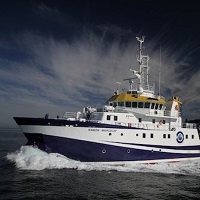Keyword
Concentration of silicon species in the water column
46 record(s)
Type of resources
Categories
Topics
INSPIRE themes
Keywords
Contact for the resource
Provided by
Years
Formats
Status
-

The objective of the DOS MARES project is twofold. First, we aim at understanding the effects of the atmospheric teleconnections between the Cantabrian Sea and the north-western Mediterranean Sea, and their impacts on the deep ecosystem, both pelagic and benthic. Second, we want to know in which way the transfer of the signal from the external forcings towards the deep ecosystem controls the community structure and the population dynamics. Thus, in March 2012 we deployed 6 mooring lines equipped with sediment traps and currentmeters in the Avilés and Gaviera canyons and the slope. In September 2012 the moorings were successfully recovered and redeployed again, and during this cruise DOSMARES BIOCANT3 they have been finally recovered and the 1-year monitoring effort finalised. In addition, CTD profiling has been performed to characterise the biological and physical structure of the water column (including the acquisition of discrete water samples), multicorers have been obtained to characterise the geochemical properties of surface sediments, and a multinet used to obtain macro- and meso-zooplankton community structure. Overall, data will allow to characterize the external forcings and abiotic conditions in the Cantabrian Sea, and thus establish the links between abiotic conditions, populations and pelagic and benthopelagic resources.
-

The objective of the DOS MARES project is twofold. First, we aim at understanding the effects of the atmospheric teleconnections between the Cantabrian Sea and the north-western Mediterranean Sea, and their impacts on the deep ecosystem, both pelagic and benthic. Second, we want to know in which way the transfer of the signal from the external forcings towards the deep ecosystem controls the community structure and the population dynamics. Thus, in March 2012 we deployed 6 mooring lines equipped with sediment traps and currentmeters in the Avilés and Gaviera canyons and the slope. In September 2012 the moorings were successfully recovered and redeployed again, and during this cruise DOSMARES BIOCANT3 they have been finally recovered and the 1-year monitoring effort finalised. In addition, CTD profiling has been performed to characterise the biological and physical structure of the water column (including the acquisition of discrete water samples), multicorers have been obtained to characterise the geochemical properties of surface sediments, and a multinet used to obtain macro- and meso-zooplankton community structure. Overall, data will allow to characterize the external forcings and abiotic conditions in the Cantabrian Sea, and thus establish the links between abiotic conditions, populations and pelagic and benthopelagic resources.
-

The objective of the project RADIALES, formulated in 1990, aims at “understanding and modelling the response of the marine ecosystem to the sources of temporal variability in oceanographic and planktonic components, particularly foccusing in those factors and processes affecting biological production and potentially altering the ecosystem services”. This project represents the oldest multidisciplinary ocean observation initiative still active in Spain.
-

The objective of the project RADIALES, formulated in 1990, aims at “understanding and modelling the response of the marine ecosystem to the sources of temporal variability in oceanographic and planktonic components, particularly foccusing in those factors and processes affecting biological production and potentially altering the ecosystem services”. This project represents the oldest multidisciplinary ocean observation initiative still active in Spain.
-

The objective of the project RADIALES, formulated in 1990, aims at “understanding and modelling the response of the marine ecosystem to the sources of temporal variability in oceanographic and planktonic components, particularly foccusing in those factors and processes affecting biological production and potentially altering the ecosystem services”. This project represents the oldest multidisciplinary ocean observation initiative still active in Spain.
-

The objective of the project RADIALES, formulated in 1990, aims at “understanding and modelling the response of the marine ecosystem to the sources of temporal variability in oceanographic and planktonic components, particularly foccusing in those factors and processes affecting biological production and potentially altering the ecosystem services”. This project represents the oldest multidisciplinary ocean observation initiative still active in Spain.
-

The objective of the project RADIALES, formulated in 1990, aims at “understanding and modelling the response of the marine ecosystem to the sources of temporal variability in oceanographic and planktonic components, particularly foccusing in those factors and processes affecting biological production and potentially altering the ecosystem services”. This project represents the oldest multidisciplinary ocean observation initiative still active in Spain.
-

The objective of the project RADIALES, formulated in 1990, aims at “understanding and modelling the response of the marine ecosystem to the sources of temporal variability in oceanographic and planktonic components, particularly foccusing in those factors and processes affecting biological production and potentially altering the ecosystem services”. This project represents the oldest multidisciplinary ocean observation initiative still active in Spain.
-

The objective of the project RADIALES, formulated in 1990, aims at “understanding and modelling the response of the marine ecosystem to the sources of temporal variability in oceanographic and planktonic components, particularly foccusing in those factors and processes affecting biological production and potentially altering the ecosystem services”. This project represents the oldest multidisciplinary ocean observation initiative still active in Spain.
-

The objective of the project RADIALES, formulated in 1990, aims at “understanding and modelling the response of the marine ecosystem to the sources of temporal variability in oceanographic and planktonic components, particularly foccusing in those factors and processes affecting biological production and potentially altering the ecosystem services”. This project represents the oldest multidisciplinary ocean observation initiative still active in Spain.
 Catálogo de datos del IEO
Catálogo de datos del IEO